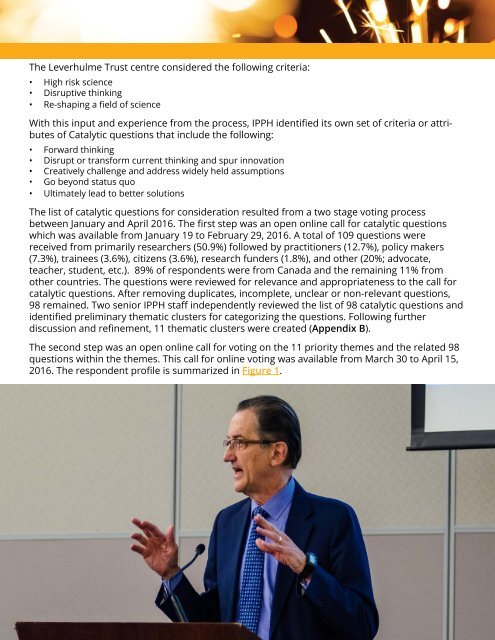sparking
Sparking-Population-Health-Solutions-Catalytic-Questions-Report
Sparking-Population-Health-Solutions-Catalytic-Questions-Report
You also want an ePaper? Increase the reach of your titles
YUMPU automatically turns print PDFs into web optimized ePapers that Google loves.
The Leverhulme Trust centre considered the following criteria:<br />
• High risk science<br />
• Disruptive thinking<br />
• Re-shaping a field of science<br />
With this input and experience from the process, IPPH identified its own set of criteria or attributes<br />
of Catalytic questions that include the following:<br />
• Forward thinking<br />
• Disrupt or transform current thinking and spur innovation<br />
• Creatively challenge and address widely held assumptions<br />
• Go beyond status quo<br />
• Ultimately lead to better solutions<br />
The list of catalytic questions for consideration resulted from a two stage voting process<br />
between January and April 2016. The first step was an open online call for catalytic questions<br />
which was available from January 19 to February 29, 2016. A total of 109 questions were<br />
received from primarily researchers (50.9%) followed by practitioners (12.7%), policy makers<br />
(7.3%), trainees (3.6%), citizens (3.6%), research funders (1.8%), and other (20%; advocate,<br />
teacher, student, etc.). 89% of respondents were from Canada and the remaining 11% from<br />
other countries. The questions were reviewed for relevance and appropriateness to the call for<br />
catalytic questions. After removing duplicates, incomplete, unclear or non-relevant questions,<br />
98 remained. Two senior IPPH staff independently reviewed the list of 98 catalytic questions and<br />
identified preliminary thematic clusters for categorizing the questions. Following further<br />
discussion and refinement, 11 thematic clusters were created (Appendix B).<br />
The second step was an open online call for voting on the 11 priority themes and the related 98<br />
questions within the themes. This call for online voting was available from March 30 to April 15,<br />
2016. The respondent profile is summarized in Figure 1.


